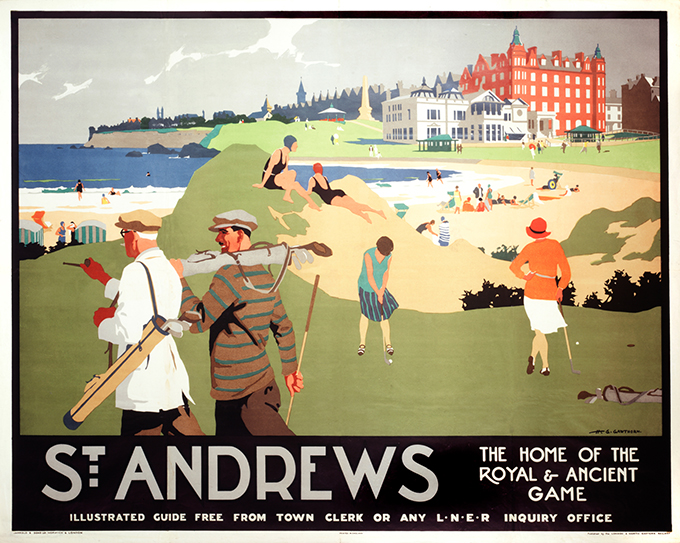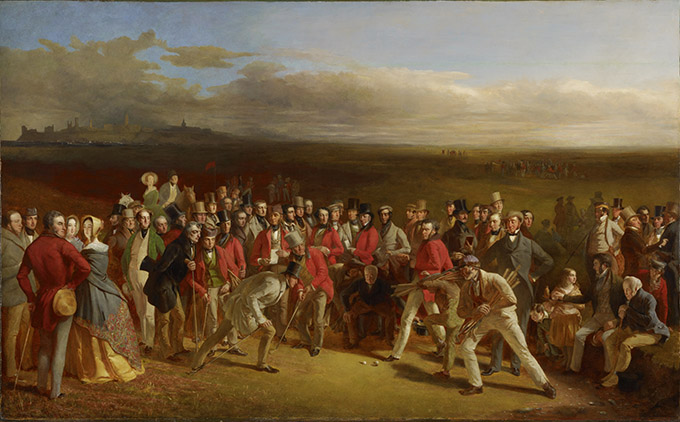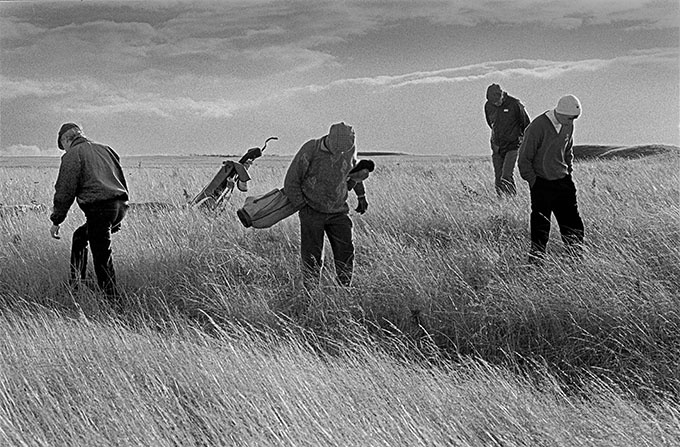With golf’s Ryder Cup coming to Scotland in 2014, and a new exhibition at the Scottish National Gallery, BRITAIN looks at the history of this most ancient of sports…

Underneath the crest of Scotland’s world-famous St Andrews Links golf course, you’ll see four simple words: ‘the home of golf’. Founded in 1754, The Royal and Ancient Golf Club (R&A) maintains the official Rules of Golf with the consent of 143 organisations from the amateur and professional game, on behalf of over 30 million golfers in 126 countries throughout the world. It is also home to the world-famous Open Championship, one of golf’s oldest four major championships, with the links course acquired by the magnificent coastal town in 1894. It is, you might say, the perfect place for golf to lay its hat.
Of such national importance, it’s no wonder that golf features in a new exhibition at The Scottish National Gallery. The Art of Golf: The Story of Scotland’s National Sport will overlap with two important events: the Commonwealth Games, Glasgow (23 July – 3 August) and the Ryder Cup, Gleneagles (23 – 28 September), the biennial competition played between teams of professional golfers representing the United States and Europe. The exhibition opens on 12 July in Edinburgh and will explore golf as a subject of fascination for artists from the 17th century to the present day, with emphasis on the emergence of the sport in Scotland.
Around 60 paintings and photographs, as well as a selection of historic golfing equipment, will feature alongside works by artists such as Rembrandt van Rijn, Sir Henry Raeburn and Hendrick Avercamp illustrating the origins of the game. The centrepiece of the show will be the greatest golfing painting in the world, Charles Lees’ famous 1847 masterpiece The Golfers. This commemorates a match played on the Old Course at the R&A, St Andrews, by Sir David Baird and Sir Ralph Anstruther, against Major Hugh Lyon Playfair and John Campbell of Saddell – the heroes of Scottish golf at that time.

A brief history of golf
The first documented mention of golf in Scotland appears in a 1457 Act of the Scottish Parliament, with King James II of Scotland prohibiting golf and football as these were a distraction from archery practice. Bans were imposed in the Acts of 1471 and 1491, while Mary, Queen of Scots was criticised for having apparently played this most unladylike and unprofitable of sports. Fortunately the ban on ‘gowf’, as it was then known, was lifted when the Treaty of Glasgow came into effect in 1502.
While golf has been played in Scotland since at least the 15th century, how it came to be played here is uncertain. It is undoubtedly close to the Netherlands game of ‘colf’, which was played over rough ground or on frozen waterways, and involved hitting a ball towards a target stick fixed in the ground. ‘Colvers’ playing on the frozen canals even appear in 17th century Dutch paintings. In Scotland the game was played over ‘links’ courses, originally rough common ground where the land meets the sea and the majority of Scotland’s famous old courses, such as St Andrews or North Berwick, are links courses.
Royal Blackheath stakes a claim to being England’s oldest golf club. It was instituted in 1608 following the ascension of King James VI to the throne as King James I of England. Since the sport had by then been played in Scotland for 150 years, James’s courtiers were able to play their beloved sport down in London on the high ground above Blackheath where documentary evidence from 1606 points to the participation of one royal player in particular: Henry Frederick, Prince of Wales and King James I’s son.
Between the mid 18th and 19th centuries, golf thrived with the establishment of some of the world’s most prominent golf clubs. On 7 March 1744, the Honourable Company of Edinburgh Golfers, the world’s oldest golf club, which now resides at Muirfield, Scotland, officially came into existence at Leith Links. That year the first 13 rules of golf were drafted for players to compete for a silver golf club, presented by the City of Edinburgh. On 14 May 1754, 22 ‘Noblemen and Gentlemen’ formed the Society of St Andrews Golfers, adopting the rules of their counterparts in Leith. 20 years later they changed their name to the Royal & Ancient Golf Club of St Andrews.
In 1860 the first Open Championship was held at Prestwick, contested by eight leading professionals. The first winner was Willie Park who received a red Morocco leather belt with silver clasps as his first prize. Around this time, a key figure in developing the game in St Andrews and Scotland was Old Tom Morris. He holds the British Open record for oldest champion at the age of 46 in 1867 and the greatest margin of victory, 13 shots, in 1862. He is also credited for his work on golf courses, including the invention of the ‘dogleg’– the sharp angles on the course – at many of the world’s best-known courses. Another golfing pioneer was James Braid. Born in Earlsferry, Fife, in 1870, Braid promoted the use of aluminium-headed putters and went on to dominate British golf in the early part of the 20th century.

By the 1860s there were fast and regular train services from London to Edinburgh and enthusiasm for Scotland in polite society helped to cause a boom in Scottish tourism, while better quality, cheaper golf balls helped popularise the sport across the British Isles, Europe and the United States. Intense competition between British golfers and their American counterparts began in the 20th century with the formation of a match-play event in 1927 – the Ryder Cup – christened after its founder, Samuel Ryder. The American team triumphed in the first Cup, but yet the rivalry remains strong to this day.
While in 1880 England had only 12 courses, by 1914 this had risen to over 1,000. Today more than 3,000 golf courses exist throughout Britain, with 188 countries belonging to the International Golf Federation, demonstrating the enduring worldwide appeal of this most Scottish of sports. Now as the country prepares to host golf’s Ryder Cup, a whole nation is geared up to welcome home its prodigal son.
Related articlesA history of Wimbledon tennisBRITAIN’s top 10 summer events |
Click here to subscribe! |
|
|||||||||||||||||







 © 2024
© 2024